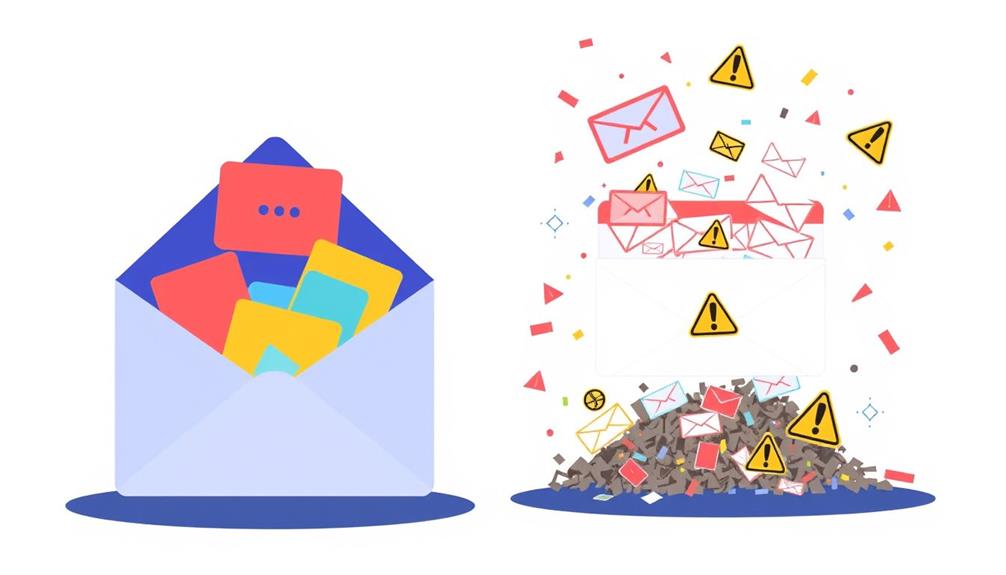Post-purchase email automations are essential for boosting customer lifetime value. By sending timely and personalized emails, you can enhance customer relationships and encourage repeat purchases. Start with immediate order confirmations and thank-you messages to build trust. Then, include product recommendations and educational content that keeps customers engaged. Remember, strategic timing is key—aim for intervals of 7 to 14 days for follow-ups. This approach not only increases engagement but also drives customers to spend 300% more. Curious about more strategies to effectively implement these automations? There's a lot more to explore on maximizing your efforts!
Key Takeaways
- Implement immediate order confirmations to build trust and set clear delivery expectations for customers.
- Send personalized product recommendations to increase average order value and enhance customer engagement.
- Utilize strategic timing for educational content to keep customers informed and reduce support inquiries.
- Encourage product reviews post-purchase to enhance credibility and foster customer loyalty.
- Segment email campaigns based on customer behavior to deliver targeted and relevant communications for improved retention.
Importance of Post-Purchase Emails

Post-purchase emails are vital tools for enhancing customer relationships and driving repeat business. They play a key role in customer retention, as nearly 75-80% of customers churn after their first order. By consistently engaging your customers through tailored post-purchase emails, you can greatly boost your customer lifetime value (CLV).
Understanding financial terms can help you allocate resources more effectively in your marketing efforts. Repeat customers spend, on average, 300% more than new customers, making it clear that nurturing these relationships is essential.
Engaging post-purchase emails have a higher open rate—about 17% more—than standard marketing emails, which means your messages are more likely to reach and resonate with your audience. By personalizing these communications, you can achieve a 30% increase in sales conversion rates, demonstrating the effectiveness of targeted strategies in maximizing CLV.
Moreover, past customers have a 27% chance of converting to repeat buyers, highlighting the importance of maintaining ongoing engagement.
To sum it up, investing in post-purchase emails not only enhances customer retention but also contributes greatly to your bottom line by increasing customer lifetime value. Don't miss out on this opportunity to strengthen your business through effective communication with your customers.
Key Components of Email Automation

To kick off a successful email automation strategy, you'll want to incorporate several key components that enhance customer experience and drive engagement. First, guarantee you send immediate order confirmation emails. This builds trust and sets clear expectations for delivery timelines. Next, consider including personalized product recommendations in your follow-up emails; this can lead to an 11% increase in average order value and a 30% rise in sales conversion rates.
Timing is essential. Space your post-purchase emails strategically to avoid overwhelming customers, with upsell suggestions ideally sent 3-7 days after the initial purchase. Additionally, utilize educational content in your automated emails to nurture relationships and reduce support inquiries.
Here's a snapshot of these key components:
| Component | Benefits | Impact on Engagement |
|---|---|---|
| Immediate Order Confirmations | Builds trust | Higher open rates |
| Personalized Recommendations | Increases AOV by 11% | Boosts sales conversion |
| Strategic Timing | Prevents customer overwhelm | Maintains interest |
| Educational Content | Reduces support inquiries | Enhances customer experience |
| Metrics Tracking | Assesses effectiveness | Improves retention rates |
Types of Post-Purchase Emails

When you finalize a purchase, a variety of email types can enhance your experience and keep you engaged with the brand.
First up is the order confirmation email. This essential message acknowledges your purchase, builds trust, and often includes tracking information, making your experience smoother. Additionally, implementing effective email marketing strategies can help brands maintain effective communication post-purchase.
Next, you'll receive a thank you email. Sent right after your purchase, this email expresses appreciation and may also provide details about future promotions, fostering loyalty.
As your order is shipped, a shipping confirmation email keeps you informed about its status. This transparency reassures you during the wait, enhancing engagement.
A few days post-delivery, you might get a product review email. This email invites you to share your feedback, turning your experience into valuable insights for the brand and improving product credibility through your voice.
Timing and Frequency Strategies

When it comes to timing and frequency in post-purchase emails, knowing when to hit send can make all the difference.
A well-structured email strategy can lead to increased engagement and customer retention, ultimately boosting customer lifetime value.
You'll want to balance your email frequency to keep customers engaged without overwhelming them.
By strategically planning your communications, you can enhance customer satisfaction and drive future sales.
This approach aligns with the importance of content relevance and authority in maintaining customer interest.
Optimal Sending Times
Timing is essential in post-purchase email automations, as it can greatly influence customer engagement and satisfaction. You should send post-purchase emails immediately after key events, like order confirmation, to leverage that initial excitement and build trust. Studies have shown that timely communication enhances customer satisfaction, so don't miss this opportunity.
Furthermore, understanding the comparative advantage principle can help you allocate resources effectively to your email marketing strategy.
During the waiting period, typically 3-7 days post-purchase, consider sending educational content emails. This keeps customers engaged and reduces any anxiety they might feel about their order.
Once the product is delivered, launch your promotional campaigns. Customers are more receptive to offers after they've received and experienced their purchase.
For ideal engagement, follow up with a request for product reviews about 7-14 days post-delivery. This gives customers enough time to use the product and form their opinions.
Additionally, segmenting your emails based on customer behavior—like distinguishing between new and returning customers—can help tailor your timing and content, maximizing relevance and effectiveness.
Frequency Balance Techniques
Finding the right email frequency is crucial for maintaining customer engagement without overwhelming them. Send too many post-purchase emails, and you risk driving away more than 30% of your customers due to fatigue.
Start strong with an immediate order confirmation, followed by a thank-you email within 24 hours. After that, space out your content. A 7-10 day interval between follow-up emails can keep your audience engaged while avoiding annoyance.
Additionally, consider incorporating insights from customer behavior analysis, similar to how the right cold medication can be selected for effective relief.
To enhance customer retention, consider sending personalized product recommendations about a week after their purchase. At this point, customers are more receptive to suggestions, having had time to experience your product.
Regularly monitor customer behavior and adjust your email frequency based on engagement metrics like open and click rates. This approach guarantees your communications remain relevant and effective.
Engagement After Delivery
Engaging customers right after delivery is vital for fostering loyalty and reducing the risk of losing new buyers. You can start by sending post-purchase emails within 24 hours of delivery, expressing gratitude for their purchase. This simple act can greatly boost customer loyalty and increase the likelihood of repeat purchases, as past customers have a 27% chance of converting again.
Additionally, incorporating user-friendly interfaces in your communication can enhance the overall customer experience.
Incorporating educational content about product use or maintenance within the first week keeps the excitement alive post-delivery. When customers receive valuable information, they're more likely to stay engaged and return for future purchases.
Timing is essential for promotional campaigns. Aim to send cross-sell and upsell emails 7-14 days after delivery. At this point, customers are more open to exploring additional purchases, having had time to experience your initial product.
Personalization Techniques for Engagement

How can you make your post-purchase emails stand out in a crowded inbox? By implementing effective personalization techniques, you can greatly enhance customer satisfaction and engagement.
Start by addressing your customers by name and including relevant details about their recent purchases. Emails that feature personalized content see open rates soar by up to 26%, making your messages more engaging. Additionally, leveraging design thinking principles can help you better understand user needs and create more impactful communications, leading to higher engagement rates user-centric solutions.
Consider adding personalized product recommendations based on their purchase history. This not only boosts average order value by 11% but can also increase sales conversion rates by 30%.
You can further enhance engagement by utilizing customer preferences collected through quizzes, allowing for targeted remarketing campaigns that resonate with your audience.
Segmenting your post-purchase emails is another powerful strategy. New customers might appreciate incentives, while returning customers might prefer simple acknowledgments of loyalty.
Additionally, personalizing educational content like tailored how-to guides related to their purchases can keep customers engaged and satisfied during the waiting period for delivery.
Leveraging Customer Feedback

Leveraging customer feedback through post-purchase emails is a game-changer for brands looking to enhance their offerings and build loyalty. By actively seeking feedback after a purchase, you can identify what your customers love or what needs improvement.
Additionally, understanding financial considerations for elderly care can also be essential in tailoring services to meet customer needs. With 70-85% of new customers potentially lost after their first order, engaging them through these emails is critical for retention.
When you implement strategies to gather customer feedback, you create opportunities for personalized marketing. Tailored product recommendations based on their preferences can lead to a 30% increase in sales conversion rates.
Plus, past customers have a 27% chance of becoming repeat buyers, highlighting the significance of acknowledging their input. Feedback also helps you uncover upsell and cross-sell opportunities, ultimately boosting customer lifetime value.
By addressing concerns and acting on insights from reviews, you foster a more engaging shopping experience. Remember, feedback isn't just about gathering data; it's about building relationships.
Integrating NPS for Insights

What if you could transform customer feedback into actionable insights? By integrating NPS surveys into your post-purchase email automations, you can gauge customer satisfaction and identify areas for improvement. Scores ranging from 0 to 7 highlight detractors, giving you the chance to address their concerns directly.
Utilizing real-time feedback, you can respond swiftly through support tools like Gorgias or Zendesk, greatly enhancing overall customer experience. Additionally, much like the themes of positivity and warmth found in uplifting music, creating a positive customer interaction can leave a lasting impression.
NPS results also allow you to segment your customers based on their feedback, paving the way for targeted remarketing campaigns. Tailoring your future communications and promotions to different customer groups creates a more personalized experience, boosting customer engagement.
For promoters, following up with invitations to join loyalty programs or referral initiatives can further solidify their positive sentiments and increase retention.
When you effectively leverage NPS insights, you not only address customer needs but also pave the way for repeat purchases. This understanding directly contributes to enhancing customer lifetime value, as strong brand loyalty develops when customers feel valued and heard.
Embrace NPS as a powerful tool to elevate your post-purchase strategy and foster long-term relationships with your customers.
Building Customer Profiles

Building customer profiles is essential for creating personalized post-purchase email content that resonates with your audience. By collecting data through quizzes, surveys, and purchase history, you can tailor your communications to meet individual preferences. This level of personalization not only enhances engagement but also greatly boosts customer lifetime value (CLV).
Here's a quick overview of how building customer profiles can benefit your email marketing strategy:
| Benefit | Impact on Engagement | Key Metric |
|---|---|---|
| Improved Targeting | Segments audiences effectively | 30% reduction in churn |
| Increased Open Rates | Personalized emails stand out | 26% higher open rates |
| Enhanced Relevance | Tailored content leads to engagement | 20% increase in interactions |
Utilizing integrated systems allows you to gather customer preferences seamlessly. Regularly analyzing these profiles helps you adapt your marketing strategies, ensuring you continuously meet customer needs. Remember, the more you know about your customers, the better your personalization efforts will be, leading to stronger relationships and increased customer lifetime value.
Increasing Customer Lifetime Value

After you've gathered valuable insights from customer profiles, you can use that information to greatly increase customer lifetime value (LTV).
One effective way to do this is through targeted post-purchase emails. When customers receive these emails, they're 60% more likely to engage with follow-up offers, which can dramatically boost their LTV. Additionally, implementing strategies like protecting your investments through informed decisions can guarantee a more secure financial future for your customers.
Implementing a customer loyalty program via post-purchase communications can also increase repeat purchase rates by up to 30%. This not only enhances LTV but also fosters a sense of brand loyalty.
Additionally, sending personalized product recommendations within a week after purchase can lead to an 11% increase in average order value (AOV), driving higher LTV even further.
Best Practices for Email Campaigns

Effective post-purchase email campaigns can greatly enhance your customer engagement and retention rates. By implementing structured email automation, you can greatly boost customer lifetime value (CLV).
Here are some best practices to keep in mind:
- Personalize your messages: Including the customer's name and tailored product recommendations can elevate open rates by 26%.
- Educate your customers: Sending valuable content in your post-purchase emails helps maintain interest and satisfaction while they await their products.
- Leverage timing for cross-selling: Sending tailored upsell and cross-sell emails a week after purchase can increase average order value (AOV) by 11% when aligned with customer preferences.
- Utilize automated workflows: Streamlining your email processes enhances communication and improves engagement metrics, fostering stronger customer loyalty.
Frequently Asked Questions
How Can You Increase Customer Lifetime Value?
You can increase customer lifetime value by building strong relationships, providing exceptional service, and offering personalized experiences. Focus on understanding your customers' needs, rewarding loyalty, and encouraging repeat purchases through targeted promotions and engagement strategies.
What Are the Three Activities That Maximize Customer Lifetime Value?
So, you think maximizing customer lifetime value is just about sending coupons? Think again! Focus on personalized recommendations, engaging educational content, and loyalty programs. These activities truly transform casual buyers into lifelong fans, boosting your bottom line.
What Are the Stats on Post-Purchase Emails?
You'll find that post-purchase emails have open rates 17% higher than average. Customers receiving them are 90% more likely to buy again, making these communications essential for boosting engagement and driving repeat purchases.
When to Send Post-Purchase Email?
Oh sure, wait weeks to send a post-purchase email! But really, you should send the order confirmation immediately, follow up with a welcome email within 24 hours, and keep customers updated as their order ships.
Conclusion
Incorporating post-purchase email automations can greatly boost your customer lifetime value. Did you know that 80% of your future profits will come from just 20% of your existing customers? By leveraging personalized, timely emails, you not only enhance customer engagement but also foster loyalty. As you implement these strategies, keep refining your approach based on customer feedback and insights to guarantee long-term success. Investing in these automations isn't just smart; it's essential for growth.










